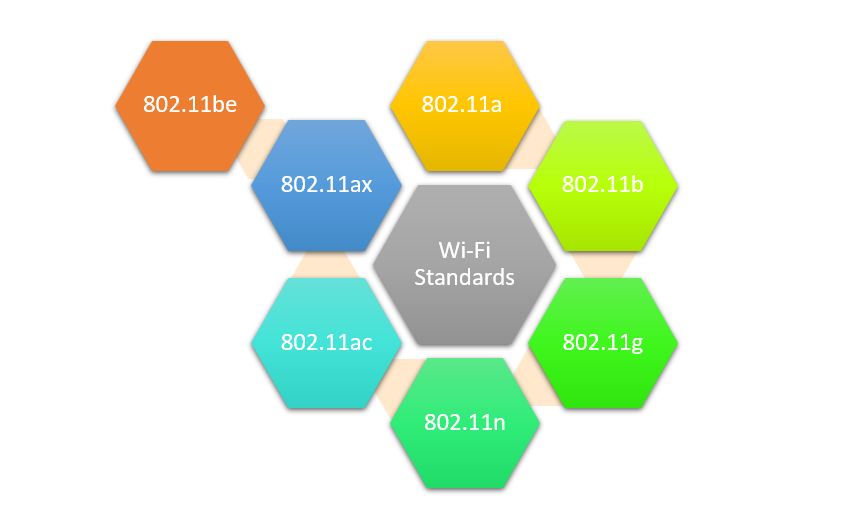In our previous post, “Beyond the Wires: Unraveling the Secrets of Seamless Wireless Communication,” we delved into the importance of wireless technology in our lives. Today, we continue our journey by diving deeper into the concepts and protocols that underpin wireless networking. By understanding technologies such as Wi-Fi (802.11 standards), cellular networks (3G, 4G, and 5G), Bluetooth, Zigbee, and the upcoming Wi-Fi 7, we’ll gain a comprehensive understanding of wireless networking and its impact on our modern world.
Wi-Fi (802.11 standards):
Wi-Fi has revolutionized how we access the internet, enabling seamless connectivity for a wide range of devices. From the early 802.11 standards to the latest Wi-Fi 7, let’s explore the unique features and improvements that each version brings:

- 802.11a: Introduced in 1999, 802.11a operates in the 5 GHz frequency range, offering faster data rates compared to its predecessors but with limited range.
- 802.11b: Also launched in 1999, 802.11b operates in the 2.4 GHz frequency range and provides a longer range at the expense of slightly lower data rates.
- 802.11g: Introduced in 2003, 802.11g combines the best of both 802.11a and 802.11b, operating in the 2.4 GHz frequency range while delivering faster speeds.
- 802.11n: Released in 2009, 802.11n introduced MIMO (Multiple-Input Multiple-Output) technology, allowing for improved data rates, range, and better performance in the presence of interference.
- 802.11ac (Wi-Fi 5): Introduced in 2013, 802.11ac operates in the 5 GHz frequency range and brings substantial improvements in speed, capacity, and efficiency. It introduced technologies like MU-MIMO (Multi-User Multiple-Input Multiple-Output) and wider channel bandwidths for enhanced performance in crowded environments.
- 802.11ax (Wi-Fi 6): Launched in 2019, Wi-Fi 6 improves upon its predecessors by introducing OFDMA (Orthogonal Frequency Division Multiple Access) and higher-order MIMO. It offers increased capacity, reduced latency, and improved performance in congested areas.
- Wi-Fi 7 (802.11be): The upcoming Wi-Fi 7 standard promises even higher speeds, increased capacity, and reduced latency. It aims to utilize advancements such as MU-MIMO and more advanced modulation techniques to further enhance performance in challenging environments.
Understanding the unique features of each Wi-Fi standard enables us to optimize network performance, select compatible devices, and stay abreast of the latest advancements in wireless connectivity.
Cellular Networks (3G, 4G, and 5G):
Cellular networks form the backbone of mobile communication, enabling voice calls, messaging, and internet access on the go. Let’s explore the unique characteristics of each cellular generation:
- 3G (Third Generation): Introduced in the early 2000s, 3G brought significant improvements over its predecessor, 2G. It enabled faster data transfer rates, better call quality, and the introduction of mobile internet access.
- 4G (Fourth Generation): Deployed around 2009-2010, 4G represented a major leap forward in cellular technology. It introduced technologies such as LTE (Long-Term Evolution) and WiMAX (Worldwide Interoperability for Microwave Access), offering significantly faster download and upload speeds, reduced latency, and improved network capacity.
- 5G (Fifth Generation): The latest cellular standard, 5G, brings transformative advancements. It offers dramatically faster speeds, reduced latency, increased device density, and ultra-reliable low-latency communication (URLLC). 5G networks utilize technologies such as millimeter-wave frequencies, massive MIMO, and network slicing to deliver these improvements, paving the way for innovative applications like autonomous vehicles, augmented reality, and smart cities.
Understanding the distinctions between 3G, 4G, and 5G allows us to appreciate the evolution of cellular networks and the capabilities they bring to our mobile experiences.
Bluetooth
Bluetooth technology has become synonymous with wireless connectivity, enabling seamless communication between devices at short distances. Let’s explore the unique aspects of Bluetooth:
- Bluetooth Classic: The original Bluetooth protocol, also known as Basic Rate/Enhanced Data Rate (BR/EDR), is optimized for data-intensive applications like audio streaming. It operates in the 2.4 GHz frequency range and provides relatively lower power consumption.
- Bluetooth Low Energy (BLE): Introduced with Bluetooth 4.0, BLE focuses on low power consumption for battery-operated devices. It enables efficient communication for applications such as fitness trackers, smartwatches, and other IoT devices. BLE excels in intermittent data transfer scenarios and offers extended battery life for connected devices.
Understanding the distinctions between Bluetooth Classic and Bluetooth Low Energy enables us to select the appropriate technology for various use cases, balancing power consumption and data requirements.
Zigbee:
Zigbee is a low-power wireless communication standard designed specifically for IoT applications. Its unique characteristics include:
- Low Power Consumption: Zigbee devices are optimized for energy efficiency, enabling battery-powered devices to operate for extended periods without frequent recharging or battery replacement.
- Mesh Networking: Zigbee operates on the IEEE 802.15.4 standard and utilizes mesh networking, allowing devices to create self-configuring networks. This enables devices to communicate with one another, extending the range and improving overall network resilience.
- Reliable and Secure: Zigbee employs strong security measures, ensuring that data transmitted over the network is encrypted and protected from unauthorized access. This makes it suitable for applications requiring secure communication, such as smart homes and industrial automation.
Understanding Zigbee’s unique characteristics allows us to leverage its capabilities for deploying robust and scalable IoT systems.
Conclusion
As we continue our exploration of wireless networking, we build upon our previous post, “Beyond the Wires: Unraveling the Secrets of Seamless Wireless Communication.” By unraveling the concepts and protocols behind technologies like Wi-Fi (802.11 standards), cellular networks (3G, 4G, and 5G), Bluetooth, Zigbee, and the upcoming Wi-Fi 7, we gain a comprehensive understanding of the foundations that support our wireless world. So, let’s dive in, connect the dots, and uncover the wonders of wireless networking that shape our modern lives.